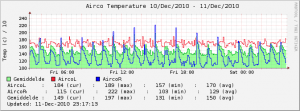Xymon Airco Temperature graph

In this case I will be using Xymon and a HWg-STE device to graph the temperature of 2 Airco units in a server room. To get this in Xymon you will need to create a custom Xymon test.
Note that in this case I am monitoring the airco output temperature (sensors in front of the airco), the overall room temperature is not measured here.
The output on the Xymon page will be something like this:
Airco_L : 167 Airco_R : 116 AverageT: 141.5 |
And the resulting graph something like this:

The HWg-STE is a SNMP enabled device so I will be using the perl NET:SNMP module to get the data from the device and import it in Xymon, which also means this should work with any snmp enabled device as long as you know the right SNMP OID’s.
First we start with the xymon ext script this is placed on the Xymon server in the ‘ext’ directory.
In this script you should change the values for the min/max temperature and ofcourse the device settings like the ip, community and oid value’s
xymon-temp01-sensors.pl:
#!/usr/bin/perl -w ############################################################################# # $Id: $ ############################################################################# use strict; ## BB and related test constants ############################################################################# use constant GREEN => 'green'; use constant YELLOW => 'yellow'; use constant RED => 'red'; # BB Global variables ############################################################################# my $bbtest = 'temp01'; my $machine = 'TEMP01'; my $color = GREEN; my $status = $bbtest . " OK"; ## Main Program ############################################################################# { use Net::SNMP; my $snmphost = '<IPOFTHEDEVICE>'; my $snmpcomm = '<SNMPCOMMUNITY>'; my $temphigha = 210; # Average Temp High my $tempwarna = 200; # Average Temp Warning my $temphigh1 = 200; # Airco1 Temp High my $templow1 = 100; # Airco1 Temp Low my $temphigh2 = 200; # Airco2 Temp High my $templow2 = 100; # Airco2 Temp Low my $session = ''; my $error = ''; # requires a hostname and a community string as its arguments ($session,$error) = Net::SNMP->session(Hostname => $snmphost, Community => $snmpcomm); die "session error: $error" unless ($session); my $result1 = $session->get_request(".1.3.6.1.4.1.21796.4.1.3.1.5.1"); die "request error: ".$session->error unless (defined $result1); my $result2 = $session->get_request(".1.3.6.1.4.1.21796.4.1.3.1.5.2"); die "request error: ".$session->error unless (defined $result2); $session->close; my $temp1 = "".$result1->{".1.3.6.1.4.1.21796.4.1.3.1.5.1"}.""; my $temp2 = "".$result2->{".1.3.6.1.4.1.21796.4.1.3.1.5.2"}.""; my $tempa = (($temp1 + $temp2) / 2); if ($temp1 > $temphigh1){ $color = "RED"; } elsif ($temp1 < $templow1) { $color = "YELOW"; } if ($temp2 > $temphigh2){ $color = "RED"; } elsif ($temp2 < $templow2) { $color = "YELOW"; } if ($tempa > $temphigha){ $color = "RED"; } elsif ($tempa > $tempwarna) { $color = "YELLOW"; } ## Send to Hobbit ############################################################################# my $report_date = `/bin/date`; chomp($report_date); system("$ENV{BB} $ENV{BBDISP} 'status $machine.$bbtest $color $report_date \n\n Airco_L : $temp1 Airco_R : $temp2 AverageT: $tempa '\n"); } |
Now we need to let the xymon server know to use this script so edit the hobbitlaunch.cfg file and add the following to the end of the file:
[temk01] ENVFILE /vol/01/xymon/server/etc/hobbitserver.cfg NEEDS hobbitd CMD $BBHOME/ext/xymon-temk01-sensors.pl LOGFILE $BBSERVERLOGS/temk01.log INTERVAL 5m |
Ofcourse we want to graph the data so edit the hobbitgraph.cfg file and add the following to the end of the file:
[temk01] TITLE Airco Temperature YAXIS Temp (c) / 10 DEF:AircoL=temk01.rrd:AircoL:AVERAGE DEF:AircoR=temk01.rrd:AircoR:AVERAGE DEF:AverageT=temk01.rrd:AverageT:AVERAGE AREA:AverageT#00FF0066:AverageT LINE1:AverageT#00BD27FF: LINE1:AircoL#F51D30:AircoL LINE1:AircoR#0000FF:AircoR COMMENT:\n GPRINT:AircoL:LAST:AircoL \: %5.0lf (cur) GPRINT:AircoL:MAX: \: %5.0lf (max) GPRINT:AircoL:MIN: \: %5.0lf (min) GPRINT:AircoL:AVERAGE: \: %5.0lf (avg)\n GPRINT:AircoR:LAST:AircoR \: %5.0lf (cur) GPRINT:AircoR:MAX: \: %5.0lf (max) GPRINT:AircoR:MIN: \: %5.0lf (min) GPRINT:AircoR:AVERAGE: \: %5.0lf (avg)\n GPRINT:AverageT:LAST:AverageT \: %5.0lf (cur) GPRINT:AverageT:MAX: \: %5.0lf (max) GPRINT:AverageT:MIN: \: %5.0lf (min) GPRINT:AverageT:AVERAGE: \: %5.0lf (avg)\n |
To add the data into a RRD file we need to change the TEST2RRD line to include our new temp01 test, so edit the hobbitserver.cfg file and add temp01=ncv to the end of the TEST2RRD config line so it will look something like this:
TEST2RRD="cpu=la,disk,inode,qtree,memory,$PINGCOLUMN=tcp,http=tcp,dns=tcp,dig=tcp,time=ntpstat,vmstat,iostat,netstat,temperature,apache,bind,sendmail,mailq,nmailq=mailq,socks,bea,iishealth,citrix,bbgen,bbtest,bbproxy,hobbitd,files,procs=processes,ports,clock,lines,ops,stats,cifs,JVM,JMS,HitCache,Session,JDBCConn,ExecQueue,JTA,TblSpace,RollBack,MemReq,InvObj,snapmirr,snaplist,snapshot,if_load=devmon,temp=devmon,temp01=ncv" |
This means the data is processed by the NCV module, default the NCV module uses DERIVE but in this case we need GAUGE (look at the RRDTOOL website for the differences) so now just add the following line below the TEST2RRD config in the hobbitserver.cfg file:
NCV_temk01="AircoLinks:GAUGE,AircoRechts:GAUGE,Gemiddelde:GAUGE" |
Edit the bb-hosts file to include the ‘temp01’ test (note that TEMP01 is also the hostname of the device)
xxx.xxx.xxx.xxx TEMP01 # testip temp01 |
And your finished, just wait a while and the test should show up in Xymon as the ‘temp01’ column.
A few notes:
- The column ‘temp01’ is only usable on 1 device in the bb-hosts, the xymon-temp01-sensors.pl script could be changed to work with the value’s from the bb-hosts file.
- The perl script could be written a bit beter 🙂
References: